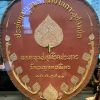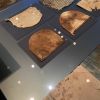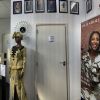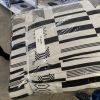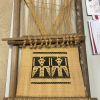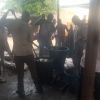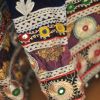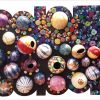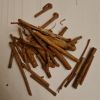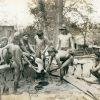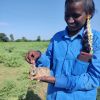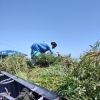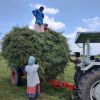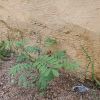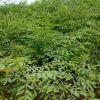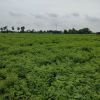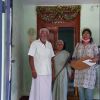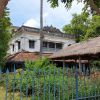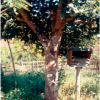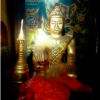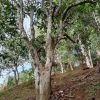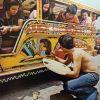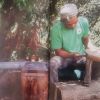The search found 278 results in 0.012 seconds.
Search results
This image is of the front edifice of the Museum de Lakenhal in Leiden, NL. Carved in the facade are representation of the spinning, weaving, and dyeing process for the historic laken textile produced in Leiden in the Early Modern Era. Through paintings of textiles and their production and the museum is dedicated to telling the history of the laken textile process that was historic to Leiden for centuries until production was halted in 1979.
As we walked through the hall of "Asia" to reach "Africa," the Volkenkunde Museum's only displayed object from Thailand caught my eye, its embroidered metal threads glinting in the dark. Embroidered script and teardop-shaped lotus buds adorn a piece of silk stretched tight around a frame to form an oblong fan that would have been held by a monk near his face as he chanted during rituals at a temple, in a homes, or in other spaces where monks are invited to preside.
These are images of caps found in the Tellem caves in Mali. They are some of the best-preserved textiles from west Africa and among the oldest yet found. They are part of a collection of finely woven and plaited objects dating from 11th- 15th centuries. For those who study African textile history, they are incredibly important as they are some of the oldest surviving West African examples of spun cotton, strip woven cloth, indigo dyeing, and certain patterning techniques still practiced in west Africa today.
A display section at the Vlisco shop space in Helmond, The Netherlands.
The clearly 'not-white' non-living mannequin, decked up in African cloth 'Made in Holland' is placed at the end of the factory space between the sanitizer and the toilet. Above the toilet door are photo frames carrying magazine covers and featured media showcasing Vlisco fabrics worn by living 'white' models.
Pictured here is a textile produced in India for the Ghanaian cloth market. It is a black and white cloth that appears to use a combination of a type of compound weave and floating warps. The patterns are taken from kente, a fine handwoven cloth originating in central and southern Ghana. It is woven in a way that imitates the structure of true kente, which is comprised of several narrow strips of cloth sewn together at the selvage. Kente is a treasured symbol of wealth and status among the Akan (the family of ethnicities to which the Asante belong) and the Ewe people.
Pictured here is an example of a Cameroonian “bag loom” set with an in-process piece of raffia cloth. It is likely from a town in the Bamenda grass fields in Cameroon’s northwest region. These particular raffia frame looms are used in Western Cameroon and southeastern Nigeria. Although distinct characteristics distinguish looms made in this weaving area, they are part of a continuum of African upright single heddle looms used from the windward coast to the Congo basin.
Field Work to Bulamari Local Dyeing Centre, Maiduguri, Borno State.
Bulamari Dyers are the Kanuri speaking indigenes of Maiduguri, Borno State. They Specializes in the production of the Kanuri tie and dye attires, especially the Kanuri blue and black fabric known as “Dongashou”.
The findings of the survey carried out at Bulamari Dyeing Center, behind the Shehu Palace in Maiduguri, Borno State are as follows:
This beautiful embroidery from Afghanistan is commonly done on velvet, in this case a soft royal blue fabric, that highlights the embroidery very well.
Beauty is the quality present in a thing or person that gives intense pleasure or deep satisfaction to the mind, it can also be a combination of qualities, such as shape, colour, or form that pleases the aesthetic senses, especially the sight.
My research is about Color Red in natural dyes.Title of my PhD research is Color matters: reconsidering plant based textile colourants. My interest in colour comes from curiosity to know more about materials , methods and techniqes to extract and apply colour . In my previous research, Song of Kalamkari, in search of golden hue in Kalamkari I intentionally looked at Colour Yellow which seemed to be an insignificant colour in the hierarchy of colours in Kalamkari. This journey took me to the Coromandel coast to Masulipatnam, Andhra Pradesh, South India.
In 1904, the United States introduced Filipino culture to the American public with their Philippine Exposition at the St. Louis World’s Fair, a faux recreation of indigenous Filipino villages located at the outskirts of the exhibition fairgrounds and populated with various indigenous Filipino tribes from across its various islands, the most well-known being of the Ifugao people of northern Luzon, referred to at the time as Igorots (Taft, 1904, 29-30).
In informal sectors, women are never considered to be put in the position for supervising. Mestiri is a tamil term to address the head workman or foreman who supervise a group of workers in informal sectors like construction, agricultural labour and production units. Generally mesthri refers to the supervisor of male gender and no title for female supervisor is found. This explains the patriarchy in work force structure of informal sector, establishing the appropriate role for men and women.
Indigo is popular globally for its usage in the dying industry. But locally a particular species of indigo has been famous among the farmers of Tindivanam town in Tamilnadu as green manure.
Neela thotti/ thotti is the tamil colloquial term that refers to the avuri (indigo) wet leaf production tank. The existence of a number of thottis in a region implies the range and scale of cultivation and production of indigo. Before the 90s in the northern part of Tamilnadu, India, indigo was cultivated on a large scale for indigo cake production with numerous thottis. The development of synthetic dyes affected the market value of natural dyes.
“Shoulder basket brand” pickled tea leaf with sesame is the very first product in Myanmar (See figure – 1) Fertilizers, as well as insecticides, have not been used in tea plantations. The forty-year-old “shoulder basket brand” pickled tea leaf company owner said “In our company, export goods are manufactured hygienically and attractively. However, goods for local consumption are not produced properly. Like foreigners, indigenous people are human beings. So many diseases occur in Myanmar because of consuming unhygienic food.
In addition to the Buddha and Nats, bicentennial tea trees are held in great reverence in Kyushaw society as benefactors and are worshipped by Kyushaw villagers. As sacred trees, the leaves of these old trees are never plucked. Every year on the full-moon day of the month of Tabaung (late February to early March), around the time of the first tea leaf harvests, the owner of the land where the bicentennial tea tree stands dresses it in “golden robes” i.e., they gild the tea tree in gold leaves using ripe bananas as glue.
The first photograph was one taken by Italian actress and photojournalist Gina Lollobrigida in 1975 Cubao, a district within Quezon City, one of the most populated cities in the Philippines. The photograph captures 6 onlookers (including the driver) watch as an artist paints onto the driver’s jeepney a man blowing wind into the mountains while the sun rises. The other photograph, of jeepney artist Vic Capuno in 2018, shows him painting a monster truck onto the side of a jeepney in his San Pedro workshop.
Magtanim Ay ‘Di Biro or ‘Planting is not a joke’ is an old children’s song from the Philippines, often sung as a nursery school rhyme. While it is considered by many (including my own family growing up) as a traditional song, the origins of the rhyme are much more recent, as I found out after being inspired by another accession card discussing Surinamese children's rhymes.
Leiden Bio Science Park was founded in 1984 at the west of the Leiden Central Train Station which is the largest and fastest-growing science assemblage in the Leiden. The 2km wide campus includes housing, a university, a hospital, restaurants, a sports center, business companies, and many others. In the photo, it mentions the model of Bio Science Park which is proposed to be set up as a lively campus.
This photograph, taken from the Philippine National Commission for Culture and the Arts (NCCA)’s book on living traditions in the Philippines, is of a trainee artisan as he pounds a brass plate into the shape of a gangsa, a round, smooth-surfaced handheld gong used by the Cordillera peoples in the Benguet region of Luzon.
Pages


